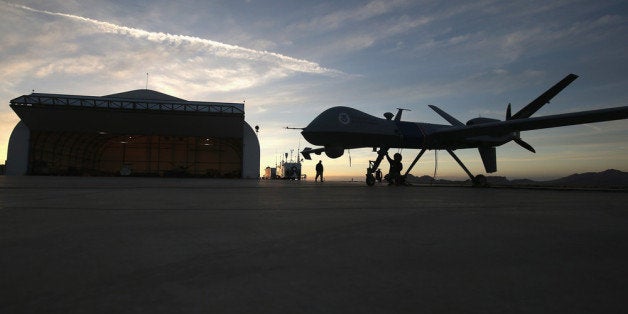
This summer, while crossing the Boston Common, I came across an anti-drone protest. Out of curiosity I approached one of the protestors handing out anti-drone fliers decrying the fact that "99% of the people that die in the CIA's robotic drone war in Pakistan are civilians." The image the protestor painted for me was of Pakistani towns on fire as robotic drones, which resembled alien spaceships from War of the Worlds, clumsily killed innocent civilians.
Having been to the tribal zones in Pakistan where the deadly Predator and Reaper drones hunt Taliban and al-Qaeda terrorists while doing research for my recent book on the subject, Predators: The CIA's Drone War on al-Qaeda, I knew the protestors' claims were wildly exaggerated. There was no way that the drones, which distantly circle over their targets for over 24 hours, monitoring their "pattern of life" movements with high-resolution cameras before firing GPS- or laser-guided mini-missiles at the enemy (who have also been monitored by spies and telephone intercepts), were engaged in the most uniquely imprecise bombing campaign in history. But wild claims by anti-drone activists dominate the conversation on drones, since the CIA and military have an official policy of not commenting on drone strikes. Average U.S. citizens cannot talk to drone pilots to find out whom they are killing based on what intelligence and why.
However, recently, at a conference on drones at Boston College, I got the extraordinary opportunity to do just that. I got to meet drone pilots and one general who controls drone operations and candidly discuss what it is like to follow human targets on the ground from cameras mounted on a drone flying two miles away and then kill them in an instant with Hellfire missiles. While one might expect the U.S.-based drone pilots who act as remote judge, jury and executioner to be cold-blooded, remorseless killers (their remotely piloted planes are called Reapers and Predators, after all), I found them to be incredibly thoughtful, introspective and deeply concerned about the notion of killing even one civilian bystander.
One Predator pilot told me that when you make your first kill, it shakes you to your core for several days, and that you never get used to it. The image of a human target you have been following closely on a camera being killed by your missile stays with you. Another drone pilot told me of an incident where he watched a known terrorist walk outside his house with children around him, causing the pilot to make the decision to hold off on killing the terrorist to avoid causing civilian "collateral damage." All the pilots vehemently rejected the notion that the "robotic" drones (which are actually not Terminator-style robots, because humans control them) lead to a video-game mentality whereby pilots don't see their targets as real humans. On the contrary, the hours spent surreptitiously spying on their targets through the lenses of high-resolution cameras allow the pilots to get to know their targets intimately in ways bomber pilots in the past could not. Killing their targets in this fashion is far more intimate and personal than traditional bombings by high-flying, supersonic bombers.
As for the claims by the anti-drone activists that the CIA's separate drone campaign is more imprecise than, say, the firebombing of Dresden during World War II or the carpet bombing of Hanoi during the Vietnam War, my own research disproves this notion. The drone pilots are aided in their precision by such tactics as the use of homing beacons, which are secretly placed on Taliban targets' cars.
Drone missiles are then fired and home in on these beacons on targets once the terrorists' cars have been driven out of civilian-packed villages. As for the drone mini-missiles, including the new 21-inch Scorpion SSW (Small Smart Weapon), they are so small that they do not create large explosions of the sort created by, say, a traditional 2,000-pound "dumb bomb." This means there is less of a chance that nearby bystanders will be accidentally killed by shrapnel in the small explosion radius. Such tactics help explain the unprecedented low civilian-to-militant kill ratios from drone strikes. According to the widely respected Long War Journal, there have been 2,706 Taliban and al-Qaeda militants killed in the drone campaign in Pakistan, at a cost of just 156 civilians.
As for the image painted for me by the drone protestors in the Boston Common that drones are flying over Pakistani cities clumsily killing civilians, the drone campaign takes place only in the remote tribal zones controlled by the Taliban. It is easy to find local tribal voices who support the drones strikes on the Taliban, who behead their maliks (elders), burn their schools, enforce harsh Shariah law, stone women, etc. The drones strike fear into the heart of the Taliban and effectively terrorize the terrorists far more than civilians who know the campaign is not targeting them.
In summary, then, I believe one needs to be skeptical when assessing the inflated civilian-death-toll claims of the anti-drone protestors. For all their fearsome names, the Predators and Reapers, while far from perfect, are engaged in perhaps the most precise, discriminating "bombing" (i.e., guided missile) campaign in history. If one accepts the fact that the U.S. and Pakistani governments cannot simply surrender to the terrorists, then the drones are the most humane solution to defeating the Taliban and al-Qaeda cancer that threatens the U.S., Pakistan and Afghanistan.
Brian Glyn Williams is a professor of Islamic history at the University of Massachusetts-Dartmouth and the author of The Last Warlord: The Life and Legend of Dostum, the Afghan Warrior Who Led U.S. Special Forces to Overthrow the Taliban Regime and Afghanistan Declassified: A Guide to America's Longest War.
